Is your portable AC on the fritz? As an HVAC engineer with over 12 years of experience, I’m going to walk you through fixing the most stubborn portable air conditioner problems.
Most mobile air conditioner breakdowns come down to four things: power issues, dirty filters, water drainage problems, or ventilation problems. A quick check of these areas solves about 80% of cooling headaches without calling in an HVAC pro.
What You’ll Need:
- User manual (or download the PDF from the manufacturer’s website)
- Basic screwdriver set
- Multimeter
- Clean cloth
Getting Started: Safety First
Always unplug your portable air conditioner before you start poking around inside. I can’t stress this enough — it protects both you and the machine’s components.
Check the obvious stuff first.
- Is the outlet working? Try plugging in a lamp or phone charger.
- Is the unit sitting flat?
- Are all vents clear?
- Do you see any kinked hoses, cracked parts, or water leaks?
I’ve talked to HVAC techs who say half their service calls end with finding a tripped breaker or a blocked exhaust hose. Many newer models flash error codes when something’s wrong — your manual will tell you what these mean. Don’t ignore these digital clues.
My Step-by-Step Diagnostic Method
Through years of troubleshooting, I’ve found this systematic approach saves time and headaches:
- Check power supply
- Is it plugged in securely?
- Does the outlet work with other devices?
- Any visible cord damage?
- Circuit breaker still on?
- Inspect the control panel
- Try resetting (unplug for 10 minutes)
- Are temperature and mode settings correct?
- Are any error codes showing?
- Do all buttons respond?
- Check airflow pathways
- Pull out and examine air filters
- Make sure the exhaust hose isn’t kinked
- Verify the window kit installation
- Can you feel the air at both intake and output?
- Look at water drainage
- Empty the collection tank
- Check for drain hose blockages
- Look around the unit for water leaks
- Is the float switch working?
- Test cooling performance
- Run it for 15-20 minutes
- The air coming out should be 15-20°F cooler than room temp
- Listen for weird noises
- Is it vibrating too much?
Still stumped? Let’s look at specific problems you might be facing.
The Most Common Portable AC Problems
Having worked as an HVAC engineer for over a decade and consulted with countless HVAC technicians, I’ve seen patterns in what breaks these units. Here are the issues my tech contacts report fixing most often.
Portable AC Won’t Turn On
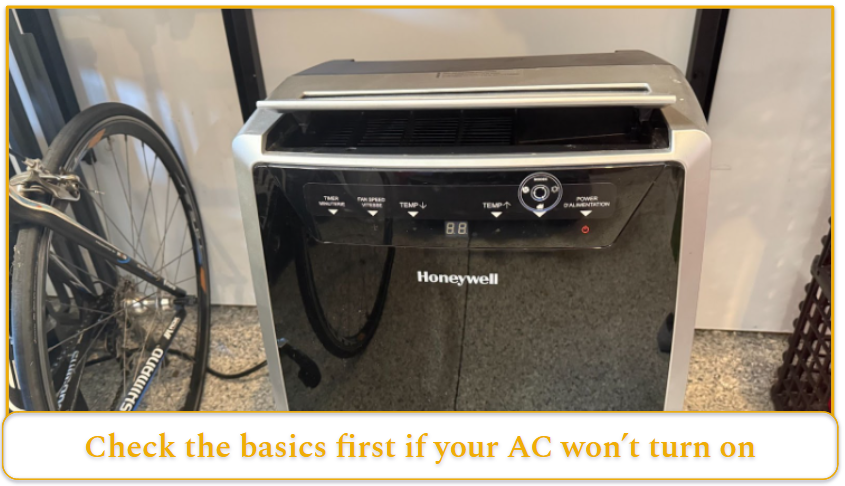
Usually, this is an electrical problem or control board failure.
- First, make sure your power cord isn’t damaged and it’s plugged in tight. Test the outlet with another device.
- If your unit has a GFCI plug, hit the reset button.
- Some models have internal fuses you can check and replace.
- If all that checks out, you likely have a failing control board or capacitor.
Portable AC Cooling, Then Stopping, Then Cooling Again
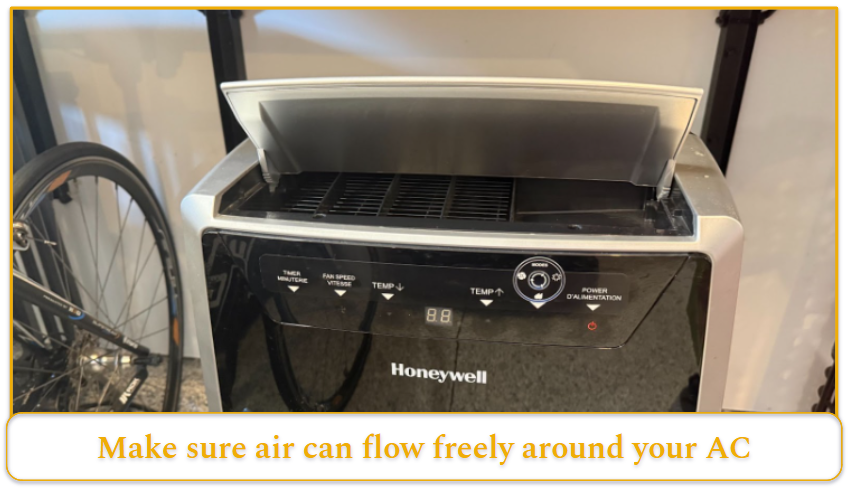
This cycling behavior typically means your compressor is overheating or your thermostat is acting up.
- Clean those filters and make sure air can flow freely around the unit.
- Check that your exhaust hose is installed right and not pinched somewhere.
- The cycling might be from a failing temperature sensor.
- Some units have built-in protection that kicks in when they get too hot – simply giving the machine more breathing room can fix this.
Portable AC Window Kit Just Won’t Fit
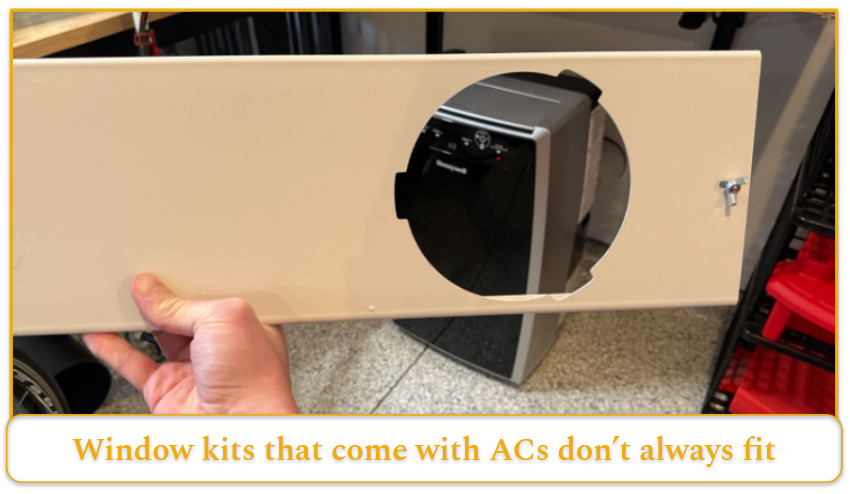
Those window brackets that come with portable ACs are notoriously limited.
- Measure your window and compare it to what your kit can handle.
- For sliding windows, you might need to cut the bracket down to size.
- Do you have an odd-sized window? Look for a universal kit or cut a piece of plexiglass with a hole for the exhaust.
- Weatherstripping works wonders for filling gaps the standard equipment can’t cover.
Running But Not Cooling
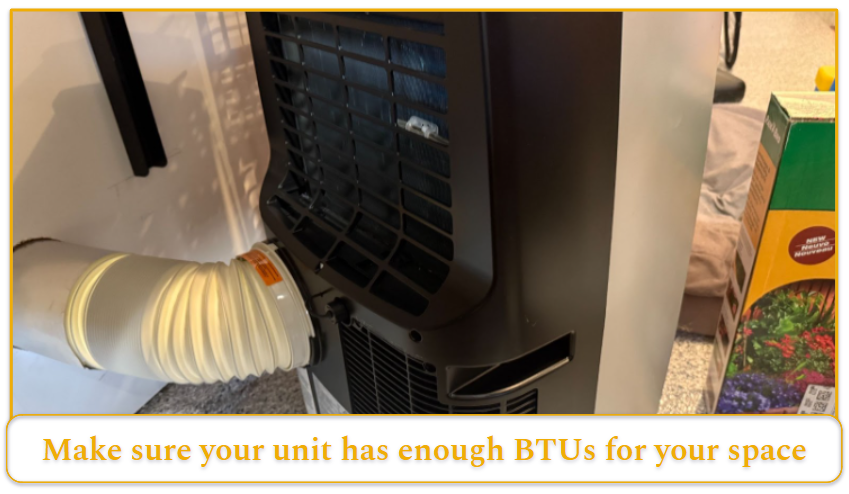
I see this all the time. First, did you get the right size unit for your space? You need roughly 20 BTU per square foot.
- Check for places where hot air sneaks in and cold air escapes.
- Keep your exhaust hose as straight and short as you can — every bend cuts the unit’s efficiency.
- In humid rooms, run the dehumidifier mode first, then switch to cooling.
Water Everywhere
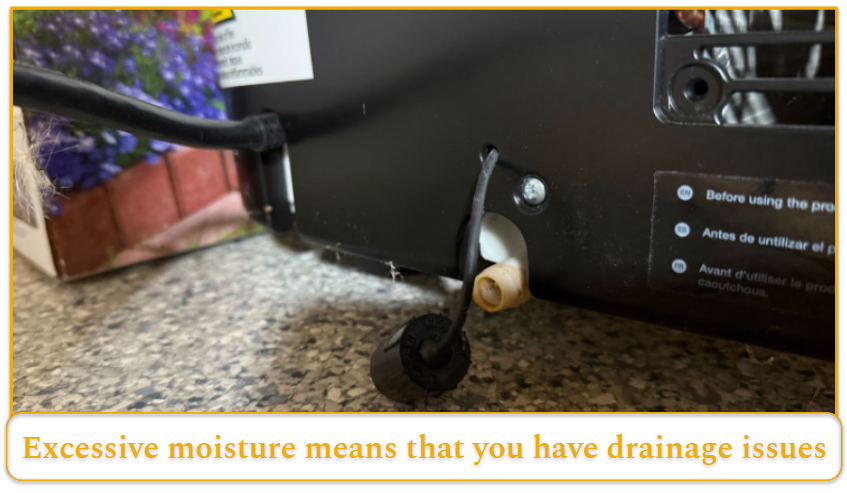
All portable units collect some moisture, but excessive water usually means drainage issues.
- Make sure the drain plug is secure on units designed to recycle condensate.
- Clear out any clogs in the drain line with compressed air or a pipe cleaner.
- For continuous drain setups, check that the hose slopes downward without any kinks.
- If your space is super humid, you’ll need to empty the tank more often or hook up a permanent drain hose.
Strange Noises
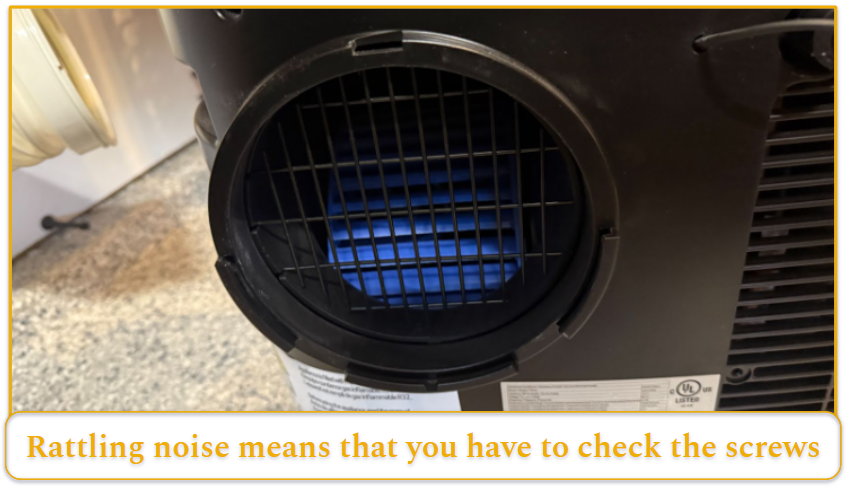
Different sounds point to different problems.
- Rattling? Tighten loose screws and check for debris in the fan.
- Grinding noises often mean the fan motor bearings are wearing out.
- Squealing might be refrigerant struggling through a partial blockage.
- A high-pitched whistle could be refrigerant leaking out, which needs professional attention.
Remote Control Dead
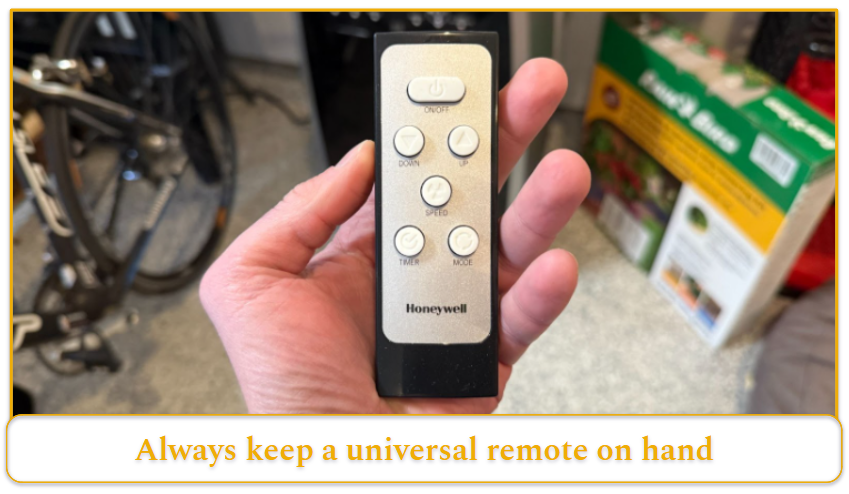
- Check the obvious – replace the batteries.
- Clean the sensors on both the remote and AC unit with a cotton swab and rubbing alcohol.
- You can test if the remote is sending a signal by looking at it through your smartphone camera while pressing buttons – you should see the IR light.
- If it’s still not working, the remote’s circuit board might be toast. Replacement remotes are easy to find online if you search for your model number.
Musty Smell
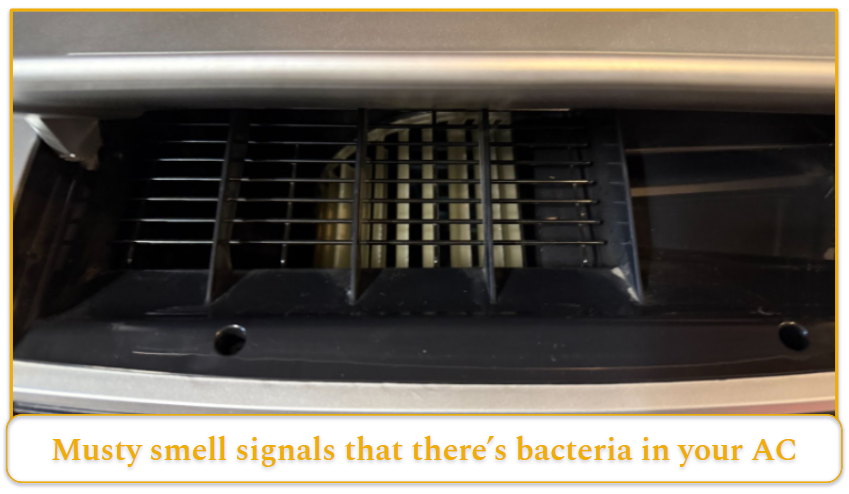
That funky odor means bacteria are growing inside.
- Thoroughly clean all filters, and the evaporator coils with a mild soap solution or a specialized AC cleaner.
- Spray the inside water collection areas with diluted bleach (1:10 ratio).
- Run the fan-only mode to dry everything out before you use it normally again.
Regular cleaning prevents the smell from coming back.
Error Codes Flashing
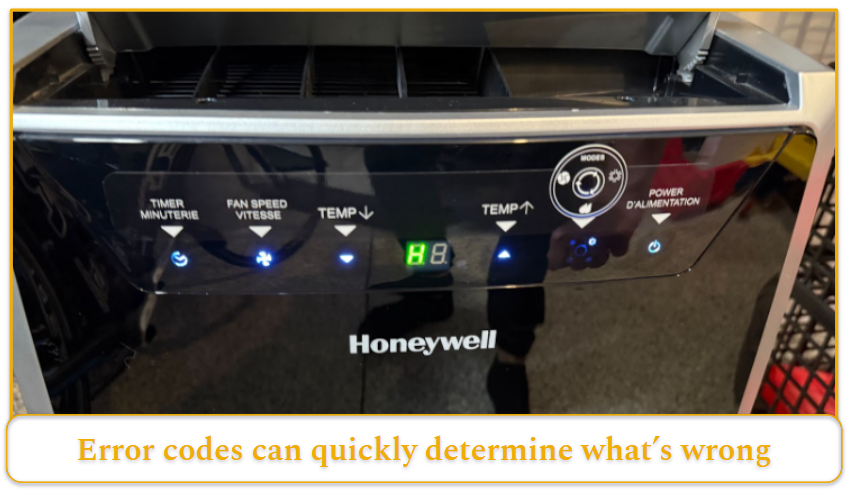
Modern units use error codes to tell you what’s wrong. Each manufacturer uses different codes, so check your manual.
Common ones include:
- E1 (water tank full)
- E2 (room temperature sensor failure)
- E4 (evaporator temperature sensor failure)
- FL (water tank full).
These codes can save you loads of troubleshooting time.
Weak Air Output
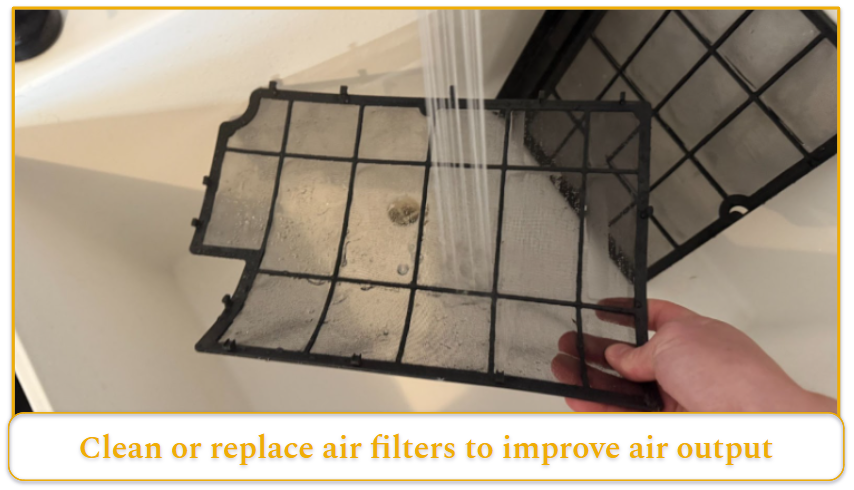
Poor airflow kills cooling efficiency.
- Clean or replace those air filters — this fixes most airflow issues immediately.
- Check for dust buildup on the coils.
- Make sure all vents are open and clear.
- The blower wheel might be clogged with lint and dust, which means taking things apart for a deep clean.
- Fan motor capacitors weaken over time and might need replacing.
Tripping Circuit Breakers
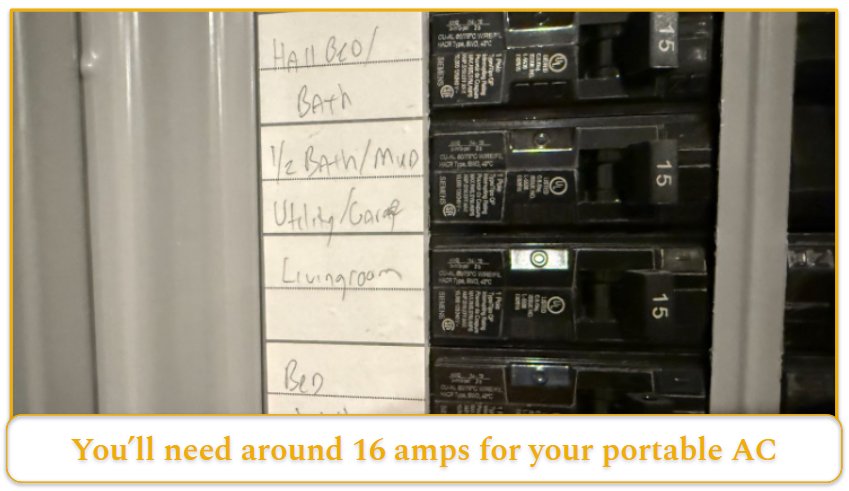
I had this exact problem in my garage workshop. My portable AC, two fans, and a battery charger for my lawn tools would trip the 15A breaker when running together. These units draw 8-12 amps during normal use and up to 16 amps at startup. See what else is running on the same circuit and move power-hungry devices to different outlets. For permanent setups, you might want a dedicated 20A circuit.
Overheating Shutdown
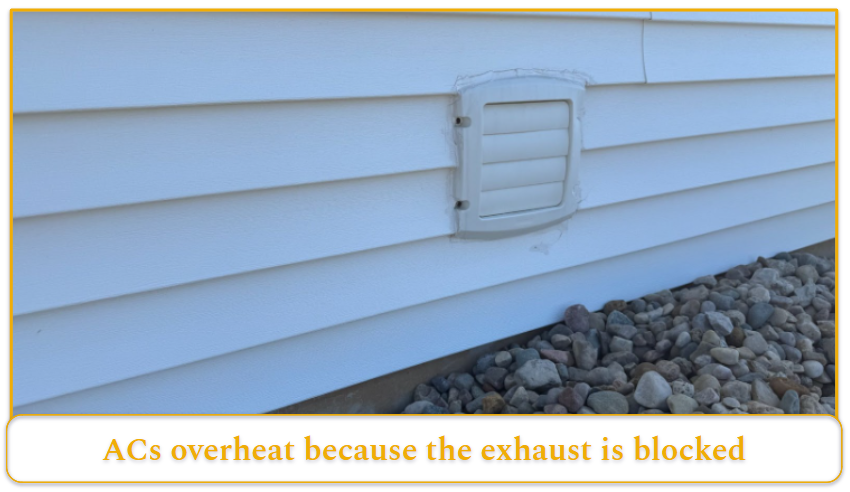
Portable ACs shut down to prevent damage when they overheat. Usually, it’s because the exhaust hose is blocked or kinked, trapping hot air inside.
- Keep at least 20 inches of clearance around all air intakes and straighten that exhaust hose.
- Dust on the condenser coils is another culprit — clean them with compressed air or a soft brush.
- And don’t place your unit in direct sunlight if possible — it makes the system work much harder.
Blowing Hot Air
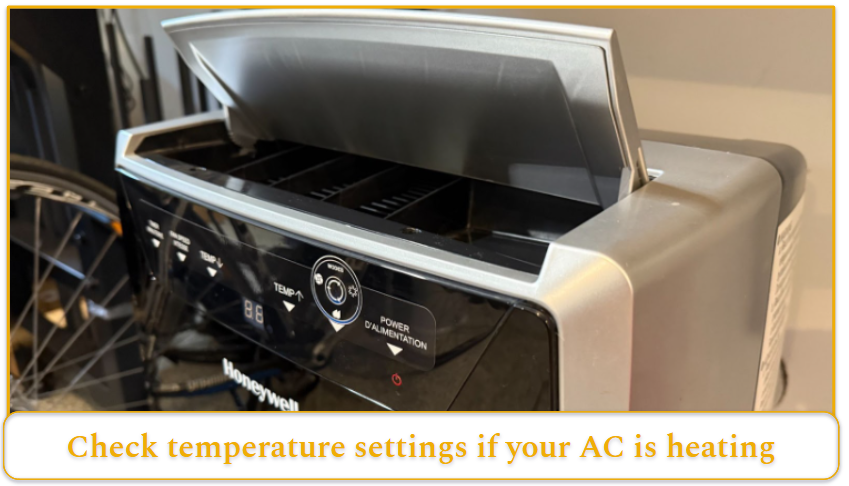
An HVAC tech I know told me about a service call where the homeowner was furious about warm air from their portable AC. After a few minutes of diagnostics, he discovered they had accidentally switched it to heating mode (their unit was a heat pump with both heating and cooling capabilities).
- First, verify your mode and temperature settings.
- If those are correct, you might have low refrigerant from a small leak.
- Other causes include dirty coils, compressor failure, or stuck valves in heat pump models. Consistently warm air usually means it’s time for professional service.
Keeping Your Portable AC Running Smoothly
Regular maintenance prevents most problems I’ve described. In my engineering career, I’ve seen hundreds of equipment failures that could have been avoided with basic upkeep.
Filter Care
Clean or replace your air filters every 2-3 weeks during heavy-use seasons. Almost all HVAC technicians agree that neglected filters cause the majority of their service calls. Clogged filters restrict airflow, forcing the compressor to work harder until it fails.
- Most portable units have washable filters — just rinse them with warm water, dry them completely, and put them back in.
Managing Water Collection
- Empty those water tanks regularly. Even self-evaporating models collect water in humid conditions.
- Check weekly in damp climates, and monthly in drier areas.
- If your unit has continuous drainage, inspect the hoses twice a season for kinks or blockages.
Keeping Coils Clean
The condenser coils need annual cleaning. When they’re covered in dust, they can’t transfer heat properly, which drops efficiency by up to 30%.
- Use your vacuum’s soft brush attachment or canned air to clean them.
- For stubborn grime, specialized coil cleaner sprays work well without damaging the delicate fins.
Inspecting Ventilation
Check your exhaust hose and window kit before each cooling season.
- Replace cracked or damaged parts. Seal gaps with weather stripping to keep hot air out.
- A technician friend taught me to coat the inside of flexible hoses with white vinegar once a year to prevent mold growth — especially helpful in humid climates.
Electrical Check-Up
- Inspect electrical connections yearly. Loose wires create resistance, generate heat, and eventually fail.
- Unplug the unit, remove the access panel, and look for discolored insulation or loose connections. This quick check prevents potential electrical fires.
Drain System Maintenance
If your unit has a condensate pump, test it before summer arrives.
- Pour water directly into the collection tank to make sure the pump activates and drains properly.
- Pumps often fail after sitting unused through winter storage.
Seasonal Care
- Before summer: Deep clean everything, test all functions and fix any issues. You don’t want to discover problems during the first heat wave when repair parts are often back-ordered.
- After summer: Run the fan-only mode for a few hours to dry out internal components. Clean filters, empty water, and check for wear. Store unplugged in a clean, dry place with the exhaust hose detached to prevent creasing.
- For winter storage, cover with a breathable material like an old bedsheet – never plastic, which traps moisture and promotes mold. Store vertically if possible to save space, but never rest it on the control panel side.
A maintenance trick from an old-school technician: Once yearly, flush the condensate system with a mix of 3 parts water to 1 part white vinegar. This prevents the slimy buildup that causes most drain clogs and eliminates musty smells in humid climates.
DIY vs. Calling a Pro
Here’s what you can fix yourself and when to call for backup:
Fixes Anyone Can Handle
Most portable AC issues are DIY-friendly. Clogged filters, drainage problems, incorrect settings, and basic cleaning need no special skills — just patience and basic tools. These fixes cost nothing but time.
Medium-Difficulty Repairs
Replacing capacitors, fan motors, or control boards requires basic electrical knowledge and the ability to follow wiring diagrams. Parts typically cost $20–$80, and there are great repair videos for the most popular models online. Always disconnect power and discharge capacitors before touching anything electrical.
When to Call in the Experts
Leave refrigerant issues, compressor failures, and sealed system problems to the pros. These repairs need specialized tools and EPA certification. Weigh repair costs ($150-300) against a new unit’s price — I typically suggest a replacement if repairs would cost more than half of what a new portable AC would run you.
Red Flags for Professional Help
Refrigerant leaks (look for oil spots or listen for hissing), electrical burning smells, or compressor failure (humming without starting) all signal it’s time for professional help. Attempting these repairs yourself can be dangerous and may violate environmental regulations about refrigerant handling.
Time for a New Unit?
For older units (7+ years), consider replacement instead of major repairs. New models offer better energy efficiency that often pays for itself through lower electricity bills within 2-3 years.
Finding Replacement Parts
From conversations with HVAC technicians, I’ve learned which parts commonly fail and how to source replacements efficiently.
- Remote controls, exhaust hoses, and window kits break most often. Smart homeowners keep universal window adapters on hand for quick fixes when original parts crack.
- Despite what manufacturers claim, many internal components work across different brands. Fan motors, capacitors, and control boards often use standard connections and mounting. Cross-reference your model’s part number with generic equivalents — you can save significantly by using universal parts with matching specifications.
- For water collection components, think beyond the manufacturer. Standard garden hose fittings often work perfectly as replacements for drain plugs and continuous drain adapters.
- When replacing exhaust parts, consider insulated hoses — they cost a bit more but reduce energy waste compared to standard ducts.


